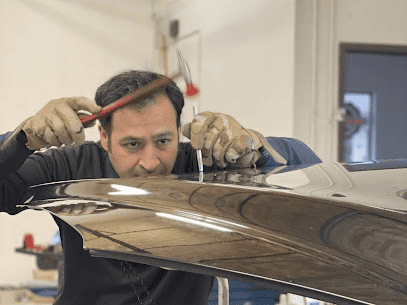
Traditional Repairs vs. Paintless Dent Repair for Hail Damage Tips From Your Experts in Austin Hail Dent Repair
Every car owner’s nightmare – a sudden hailstorm leaving their once pristine vehicle peppered with dents and dings. Hail damage can be a frustrating and costly problem, but fortunately, there are solutions.
The real challenge lies in choosing the right repair method. We’ll explore two primary options for addressing hail damage: traditional repairs and Paintless Dent Repair (PDR).
By the end, you’ll have a clear understanding of the advantages, limitations, and factors to consider when deciding between these two approaches.
Traditional Repairs
Traditional repairs for hail damage typically involve a multi-step process. First, the damaged area is assessed, and the dented sections are filled and sanded to create a smooth surface. Afterward, the repaired area is repainted to match the car’s original finish. Traditional repairs excel at restoring a car’s aesthetic appeal, making it look as good as new.
One of the primary advantages of traditional repairs is their ability to restore the car’s original appearance. When done correctly, it’s nearly impossible to spot any evidence of previous hail damage.
However, this level of craftsmanship comes at a price – both in terms of cost and time. Traditional repairs tend to be more expensive due to the labor-intensive nature of the process. The time required for traditional repairs can be a drawback, leaving you without your vehicle for an extended period.
Paintless Dent Repair (PDR)
PDR offers a different approach to hail damage repairs. Instead of the extensive filling, sanding, and repainting involved in traditional repairs, PDR focuses on massaging out the dents from the inside. Technicians use specialized tools to access the backside of the dent, gently working to reshape the metal until it returns to its original state.
The most significant advantages of PDR are cost-effectiveness and speed. Since PDR avoids the need for extensive materials and labor, it is often a more budget-friendly option. PDR is known for its efficiency, with many repairs completed in a fraction of the time it takes for traditional repairs.
However, it’s essential to note that PDR is not a universal solution. It is most effective for smaller dents that haven’t compromised the paint and finish.
Factors to Consider
When it comes to choosing between traditional repairs and PDR for hail damage, several critical factors should guide your decision:
Extent of Damage: Consider the severity and quantity of dents on your vehicle. While PDR is excellent for minor dents, traditional repairs may be necessary for more extensive damage.
Budget: Evaluate your budget for repairs. PDR often offers cost savings, but the price can vary based on the extent of the damage.
Insurance Coverage: Your auto insurance policy may influence your decision. Some insurance companies may prefer or even recommend PDR due to its cost-effectiveness. Check your policy details and consult with your insurance provider to determine coverage options for both repair methods.
Long-Term Value: Think about the long-term value of your vehicle. If you plan to keep your car for an extended period, investing in traditional repairs may be worthwhile as it can maintain the car’s resale value.
Consulting a Professional: The best way to decide between traditional repairs and PDR is to consult a professional. An experienced technician can assess the damage and recommend the most appropriate repair method for your specific case.
Environmental Impacts and Convenience
Considering the environmental impact and convenience is crucial when choosing between traditional repairs and PDR. Traditional repairs typically involve more materials, including paint and filler, which can have environmental implications. On the other hand, PDR is an eco-friendlier option as it generates less waste and doesn’t require paint or solvents.
In terms of convenience, PDR shines as it often allows you to keep your vehicle for a shorter time. This can be especially advantageous if you rely heavily on your car for daily activities.
Traditional repairs, while thorough, may leave you without your vehicle for an extended period, inconveniencing your daily routine.
Paintless Dent Repair in Austin: Making an Informed Decision
Hail damage is an unfortunate reality for many car owners. When faced with this challenge, it’s essential to make an informed decision regarding repairs. Traditional repairs offer a meticulous restoration of your car’s appearance but come at a higher cost and longer repair time. PDR, on the other hand, provides a cost-effective and efficient solution for smaller dents.
To make the right choice, assess the extent of damage, your budget, and your time constraints. Consult with a professional who can evaluate your vehicle and recommend the most suitable repair method. Remember, the choice between traditional repairs and PDR ultimately depends on the unique circumstances of your hail damage situation.
Hail damage may be an unwelcome surprise, but you have options. Whether you prioritize a full aesthetic restoration or a budget-friendly, speedy solution, both traditional repairs and PDR offer their advantages.
With the guidance of a professional and a clear understanding of your specific needs, Austin PDR estimate can restore your vehicle to its former glory and hit the road with confide